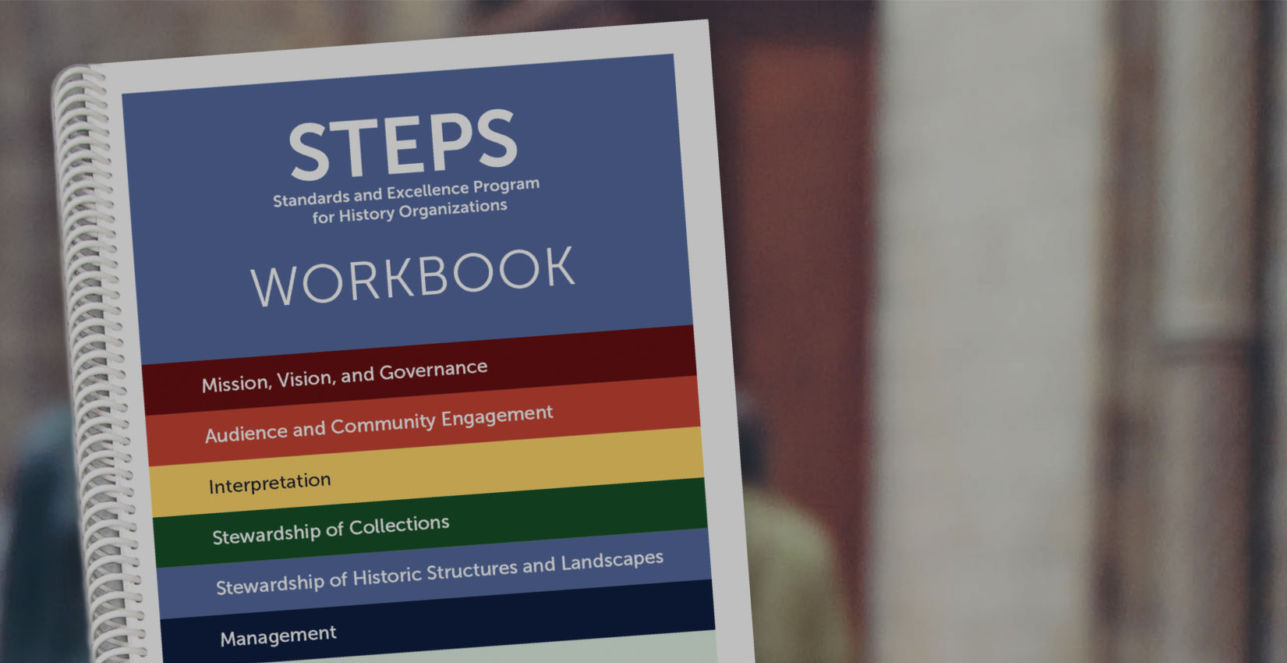
By John Dichtl, AASLH President and CEO
After ten years of helping more than 1,100 institutions move forward through self-assessment, this month AASLH relaunches the Standards and Excellence Program for History Organizations (STEPS). This is an exciting moment for a great program that has become even better.
If you are familiar with STEPS, you know it is a blueprint, a guide to improving the practices and policies of history institutions. STEPS helps small and mid-sized history museums and historical societies see the total picture and to function more effectively. Piece-by-piece, attending to the small things can add up to big change. Crucially, STEPS is designed to dovetail with the work you are already doing. It is not meant to add to your workload, but instead to help your organization set and attain reachable goals.
When STEPS appeared in 2009, it was the first time the field had performance indicators to help organizations figure out how close they were to national standards. With dozens of colleagues and partner institutions, we built STEPS on the standards in the museum field’s Continuum of Excellence. That means STEPS has always shared many of the same standards with the American Alliance of Museums’ MAP and Accreditation Programs. Advancing from STEPS to these programs is a smooth transition. And because the performance indicators were broken into “Basic” achievement, “Good” and “Better” in the STEPS Workbook, it is always clear how close you are to meeting national standards and exactly what you need to do to get there.
Step-by-step, institutions can benchmark themselves in six areas: Mission, Vision, and Governance; Audience and Community Engagement; Interpretation; Stewardship of Collections; Stewardship of Historic Structures and Landscapes; and Management.
So what’s new with the program as of 2021? Well, there is a wholly refreshed online community site providing discussion space and supplying supplementary materials for those enrolled in STEPS. Some of the best advice comes from conversations with peers who are engaging with the same questions that you are.
Most importantly, the STEPS Workbook has been comprehensively revised. Beginning in 2017 with the help of an army of volunteers and contributors, we addressed changing expectations in the field, particularly in the areas of inclusion, equity, community engagement, relevance, financial management, and digital collections. Seven overarching standards—covering issues of public trust, accountability, inclusion and equity, ethics, environmental sustainability, and technology—have been integrated into each of the six main subject areas. In addition, the language used for the performance indicators is more clearly scaled. That is, at the “Basic” level, institutions are called on simply to be “aware,” to “describe,” or to “discuss” questions, practices, and policies related to the national standards. At the “Good” level, they are called on to take more active steps: “develop,” “create,” “collect,” “adopt,” or “consult.” And at the “Better” level, institutions are asked to “commit” to or take higher-level action on more challenging objectives, sometimes involving stakeholders or outside experts.
AASLH is not only releasing this improved version of STEPS, we are using it to strengthen and systematize all our professional development offerings. The national standards outlined in STEPS will be addressed, step-by-step with performance indicators, in AASLH’s growing curriculum of webinars, workshops, and online courses.
In other words, each AASLH learning opportunity should help STEPS participants make progress towards achieving “Basic,” “Good,” and “Better” levels.
We were fortunate to have so much assistance in enhancing this program. AASLH’s Cherie Cook, who helped to create STEPS and who single-handedly administered the program for more than a decade, distilled suggestions from many colleagues and completed months of editing in late fall before retiring from AASLH. I am enormously grateful to her for making this great program ever-better. She always saw that STEPS was an incredibly valuable tool for positive change. There are many other colleagues to thank, especially Nina Zannieri of the Paul Revere Memorial Association, Scott Wands of Connecticut Humanities, and Max van Balgooy of Engaging Places LLC for their commitment to making STEPS stronger and more widely used. They and others have provided many hours of direction to this program, and the staff and I are grateful.
As a participant once recalled, “STEPS helped us be more forward thinking rather than getting stuck in day-to-day challenges.” I believe that sums up the value of the program. Like any good assessment or planning tool, STEPS requires an investment of time that will pay off many times over. One has to step back from the daily press of obligations to look at the bigger picture, and then make adjustments piece-by-piece, practice-by-practice, policy-by-policy. Over the years, STEPS participants have shared their successes in doing this: “Our credibility in the community has increased as people understand we are committed to this assessment process.” Another reported: “STEPS showed us we’re on the right track and, more importantly, it made our board understand there’s a reason why we have to pay attention to these things.”
With the relaunch of STEPS, we invite all history organizations to join those who are using the program to become stronger, more effective institutions. If you are interested in learning more about meeting national standards and best practices, visit our website to enroll in the updated program or join us February 3 for a free informational webinar, Is Your Organization Ready for Self-Assessment? Already enrolled in STEPS and looking to start fresh? Email learn@aaslh.org and we will help you get started with the new workbook and online STEPS Community.
